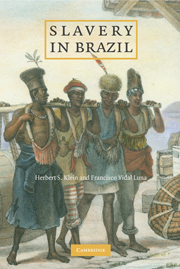Book contents
- Frontmatter
- Contents
- Preface
- I THE POLITICAL ECONOMY OF SLAVE LABOR
- 1 Origins of the African Slavery in Brazil
- 2 The Establishment of African Slavery in Brazil in the Sixteenth and Seventeenth Centuries
- 3 Slavery and the Economy in the Eighteenth Century
- 4 Slavery and the Economy in the Nineteenth Century
- 5 The Economics of Slavery
- II BRAZILIAN SLAVE SOCIETY
- III END OF SLAVERY
- Bibliography
- Index
4 - Slavery and the Economy in the Nineteenth Century
Published online by Cambridge University Press: 05 June 2012
- Frontmatter
- Contents
- Preface
- I THE POLITICAL ECONOMY OF SLAVE LABOR
- 1 Origins of the African Slavery in Brazil
- 2 The Establishment of African Slavery in Brazil in the Sixteenth and Seventeenth Centuries
- 3 Slavery and the Economy in the Eighteenth Century
- 4 Slavery and the Economy in the Nineteenth Century
- 5 The Economics of Slavery
- II BRAZILIAN SLAVE SOCIETY
- III END OF SLAVERY
- Bibliography
- Index
Summary
The evolution of Brazilian slave society in the nineteenth century is defined by several important developments. The first was the emergence of a new export crop, coffee, which would form the basis of a new slave plantation economy in the southeastern states. The second was the continued growth of the traditional colonial plantation crops. Sugar again became a world-competitive product with the decline of the sugar industries in both Saint Domingue and the British West Indies, and Brazilian cotton production, which, after suffering severe competition from the southern United States in the first half of the century, revived in the period of the world's cotton famine in the 1860s during the North American Civil War. Finally, there was also the continued growth of the slave population of Minas Gerais – the largest in Brazil – in a region that was primarily dedicated to production for the internal market and yet that retained and expanded its slave population even in the era of the internal slave trade.
The growth of all these traditional and newer export crops created an increasing demand for slaves, and the Atlantic slave trade reached its peak in the third decade of the nineteenth century. But the closing of the trade in 1850 led to both a secular rise in slave prices and the consequent expansion of the internal slave trade by both land and sea in the next two decades, until the interprovincial slave trade was finally abolished in the last decade before emancipation.
- Type
- Chapter
- Information
- Slavery in Brazil , pp. 74 - 114Publisher: Cambridge University PressPrint publication year: 2009



